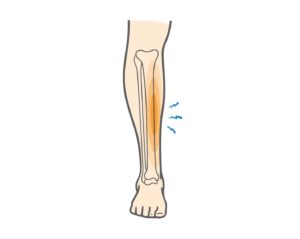Running season is starting up again, and with a whole range of great events in Sydney creeping up on us, it is easy to rush training and get injured.
One injury in particular that plagues runners of all abilities is shin splints, or medial tibial stress syndrome (MTSS).
MTSS presents as a dull, achy pain located around the inside of the lower shin, which is worst at the beginning of exercise but often eases with activity.
It is also painful on palpation across a length of 5cm or more.

What is MTSS?
There are various hypotheses as to the underlying pathology of MTSS.
Some believe it is due to fasciopathy (irritation of connective tissue), while more recent evidence in athletes attribute it to bone overloading.
It is suggested that there may be impaired bone repair in these cases, due to an imbalance between bone resorption and bone creation.
However, as there is still limited evidence on its pathology, MTSS is considered a syndrome based on its symptoms.
What causes MTSS?
The cause of MTSS is often multifaceted, with a combination of poor training and biomechanical abnormalities.
Risk factors identified in the literature include:
- Female sex
- Previous history of MTSS
- Fewer years of running experience
- Orthotic use
- Increased BMI
- Increased navicular drop (collapse of the arch of the foot)
- Increased external rotation hip range of motion
How can I fix it?
If not properly managed, shin splints can severely disrupt training and progression in one’s sport, and progress into more serious conditions that may be harder to treat.
Despite its high prevalence, there is no high quality evidence for the effect of any intervention in treating MTSS, which makes it unclear which treatment is most effective.
Some proposed treatment modalities include gait retraining, rest, ice massage, shockwave therapy, stretch and strengthening exercises, graded running programs, lower leg braces and injection therapies.
However, in the absence of good evidence for any of these treatments, physiotherapy prioritises clinical reasoning to develop treatment regimens specific to the person in front of them.
Fundamentally, MTSS management programs should incorporate:
- Pain management in the acute phase
- Load modulation
- Graded tibial loading program
- Ankle plantar flexor (calf) strengthening

If you are being held back in your running or sport from shin splints, book in for a consultation today with one of our physiotherapists for a comprehensive assessment and treatment program. We’ll get you back on track!
References
- Newman P, Witchalls J, Waddington G, Adams R. Risk factors associated with medial tibial stress syndrome in runners: a systematic review and meta-analysis. Open Access J Sports Med. 2013 Nov 13;4:229-41. doi: 10.2147/OAJSM.S39331. PMID: 24379729; PMCID: PMC3873798.
- Reinking, M. F., Austin, T. M., Richter, R. R., & Krieger, M. M. (2017). Medial Tibial Stress Syndrome in Active Individuals: A Systematic Review and Meta-analysis of Risk Factors. Sports Health, 9(3), 252–261. https://doi.org/10.1177/1941738116673299
- Winters, M., Eskes, M., Weir, A. et al. Treatment of Medial Tibial Stress Syndrome: A Systematic Review. Sports Med 43, 1315–1333 (2013). https://doi.org/10.1007/s40279-013-0087-0
- Winters, M. The diagnosis and management of medial tibial stress syndrome. Unfallchirurg 123, 15–19 (2020). https://doi.org/10.1007/s00113-019-0667-z

